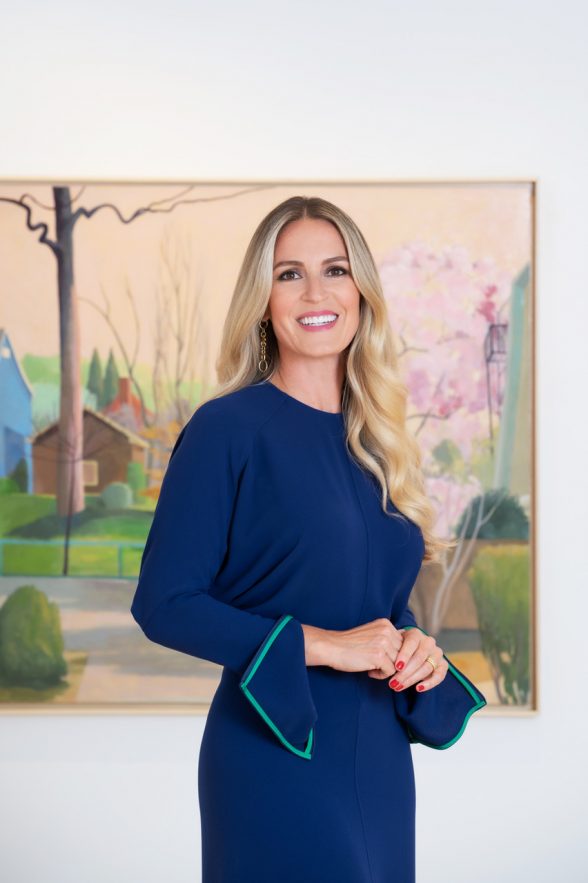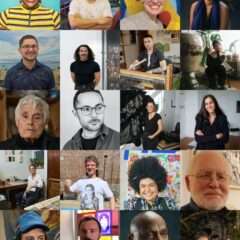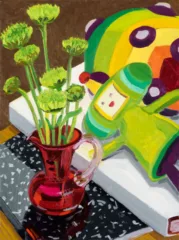Elizabeth Johnson sits down for an interview with Rebecca Segall, owner and Director of Gross McCleaf Gallery and learns about why the artist/maker/gallerist bought the gallery in 2020 and how it’s going. The gallery has a new website with an online shop for internet sales. And the gallerist shares thoughts about art fairs and whether Philadelphia should support one. The interview was edited for length and clarity. Full disclosure: Elizabeth interviews artists for Art Sync under Viewing Room on the Gross McCleaf site.

Elizabeth Johnson: You mention in a Philadelphia Style magazine that being an admirer and patron of Gross McCleaf and engaging with its artists inspired you to buy the gallery. Preserving and supporting the vibrant Gross McCleaf community is very important to you. How did you first connect with the Gallery?
Rebecca Segall: I moved to the city five and a half years ago when I became an empty nester. I was studying at PAFA, decorating my kitchen and I wanted to buy art locally. My advisor at school, Douglas Martenson, mentioned that he was showing at Gross McCleaf, so I came to the gallery with the idea of supporting a local art business: I ended up buying two pieces. Right now, I have a personal collection of almost 50 pieces–works that I constantly move around, that I need to see since they are endearing to me. I install many of the pieces salon style outside my apartment across from the elevator, because it’s a shame to waste beauty in storage.
Gross McCleaf has been a fixture in the Philadelphia art community for over fifty years. My decision to take over the gallery was inspired by its history. It was clear that my role would be one of steward to the legacy. Gross McCleaf has exhibited many well-known artists, some of whom got their start on our walls: Mariel Capanna, Larry Day, Rackstraw Downes, Aubrey Levinthal, Jane Piper, Fairfield Porter and Neil Welliver. And we are cultivating current rising stars such as Ed Bing Lee, Joseph Lozano, Mickayel Thurin, Bethann Parker and Nicole Parker.
EJ: Estelle Shane Gross opened Gross McCleaf in 1969, Sharon Ewing bought it in 1992, and you bought the gallery in November 2020. Sharon is still onboard and a great help. What is her role now?
RS: Sharon originally stuck around to create a smooth transition for our artists, clients, and the staff – Morgan and Emma. She taught us how to operate various databases and introduced us to friends of the gallery. Sharing her experience has been invaluable and she bridges us with the inception of Gross McCleaf. What I enjoy the most are the wonderful stories that she tells so casually. I love hearing about unique sales/client relationships, tales of the city, and stories about Estelle Gross in particular. I adore Sharon and will always consider her to be the gallery director emeritus at Gross McCleaf.
EJ: In your ABC interview with David Murphy, you say, “Why start a new gallery when you can carry on this great legacy?” How has the goal to run a NYC style gallery that supports Philadelphia artists function differently now in 2022 in comparison to Estelle and Sharon’s eras? After two years at the helm, do you find yourself reweighing strategies?
RS: Estelle Gross said in a 1989 interview with the American Archives of Art at the Smithsonian, “if you forget that you’re running a business, you will soon be out of business.” This makes me laugh, but of course it is serious. It would be only fun if we could show art and connect with artists and didn’t have to pay for rent, payroll, insurance, marketing, and utilities; nevertheless, that’s the cost of commitment.
Estelle was interviewed by Marina Pacini and was wonderfully expressive about the challenges of being a woman gallerist and not being taken seriously. There was a cadre of others coming up at that time like Sande Webster, Marian Locks, Barbara Sylk and others in Old City who were responsible for creating an art scene. Anyways, being a woman gallerist is not such a challenge as it once was, but the business of selling original art is the same. Communicating what you think is good and worth taking home to enjoy has not changed. The challenge continues to be regular sales and expanding a collector base.
EJ: What business were you in before Gross McCleaf?
RS: I’ve always been a maker, and I’ve always yearned to study art, but I got married early and had three kids right away, so art school had to wait. After my first marriage ended, I decided I’d get into acting to make some extra money, and was sent out by the Gail Williams Agency based on my “soccer mom” appeal. I was doing a lot of different things at that time: I made and sold jewelry for a gallery in West Chester, PA, sold real estate in Fishtown for a couple years, and worked as a presenter for 7 years on QVC. Nothing is wasted in human experience, especially when it comes to jobs: they’ve all provided me with skills that I use to this day. I agree with my friend Jen who says, “the cause is in the future.”
EJ: How did assistant director Morgan Hobbs support your decision to buy the gallery? And what is her operating role?
RS: Morgan Hobbs is an awesome Assistant Director. She and I knew each other at PAFA, and she helped Sharon Ewing before the gallery changed hands, so our familiarity was something that we could build on. Morgan is a practicing visual artist: I enjoy and respect her work a great deal. She was a founding member of AUTOMAT gallery, so she has experience jurying work, managing artists, scheduling exhibits and writing, among many other gallery-related duties.
My daughter Emma Rose Cook is our Registrar. She’s a natural creative, has excellent customer relation skills, and has helped us so much with technical issues. We’re all passionate about art, about artists from the Philadelphia region in particular; I love that we’re a team that seems to share the same creative brain.

EJ: You studied art at PAFA and majored in painting. How would you say your PAFA education nourishes and influences your vision as a gallerist?
RS: I majored in Painting at PAFA, but my work shifted toward three dimensions and installation projects toward the end of my studies. I’ve been a maker throughout my life. I’ve created handmade jewelry, quilts, and art objects made from materials of all kinds. I relished every elective course I encountered in school: bookmaking, woodcut and intaglio printmaking, mixed media, video art, sculpture and found objects classes–they were truly immersive and life changing. Lately, when I have time, I focus on repurposing textiles. As a cross-disciplinary artist, I remain totally open to exploring whatever medium catches my eye. Overall, my time at PAFA served to formally ratify my pursuits and draw me further into the community of Philadelphia artists. Being a gallerist and an artist gives me an appreciation for the time, courage, and commitment necessary for a creative life. I know it can be a challenge to maintain a regular studio practice, let alone, prepare for exhibitions on a regular basis.
EJ: How did business fare through the Pandemic? Are sales steady? Any sign of a recession? Do you have a masking requirement?
RS: We don’t currently have a masking requirement in the gallery. I bought the gallery in November 2020 and did a cosmetic remodel in December. We reopened the gallery and launched the new website on January 6, 2021. Luckily, we didn’t have to close for the pandemic as Sharon did in 2020. Throughout 2021 people were so eager to reconnect, they were thrilled to reengage with art in person, in a gallery setting. By 2022, sales were mostly driven by repeat customers or visitors who come in for a particular artist’s exhibition.
EJ: Does the gallery own the building or rent? Any plans for an elevator to make the gallery more accessible? Do you have any additional remodeling plans for the space?
RS: We rent, so we don’t have plans for an elevator, plus the building is so old, it has different code requirements. When we renovated the space, we were able to create a third gallery in addition to the original two, upgrade lighting and HVAC, and reorganize our extensive storage areas.
EJ: Are openings busy even though there are not many galleries in your area?
RS: There are fewer office workers downtown after Covid. But openings have been well attended and are scheduled on the first or second Saturday of the month from 1-4 pm. This window seems to work well for our artists, clients, and visitors and doesn’t seem to conflict with other art events in Philadelphia. Saturdays also accommodate suburban commuters and out-of-town visitors. First Friday worked better when there were more people working full time in the city who supported gallery hopping as an after-work thing. But in my opinion, First Fridays were too spread out. It was hard to get to Old City, Fishtown and Rittenhouse in one night, and re-parking is time-consuming and expensive. Morton Contemporary and Commonweal Gallery opened recently in the neighborhood, and Works On Paper Gallery is just around the corner. I hope there will be more galleries opening.
EJ: Are you pursuing online sales?
RS: Over the last two years, we have increased our online and social media visibility through a new website platform, regular social media posting and bi-monthly email blasts. We have built on the foundation created by Sharon. We were also pleased to begin offering online sales through our website. Our goal is to make it easy to purchase artwork from Gross McCleaf, no matter where you live.

EJ: Considering that sales tax is required on all art sales in Philadelphia, would you consider advocating and/or organizing for Tax-Free First Fridays on behalf of struggling art galleries? Or are there better advocacy issues that the city could implement that would help galleries survive?
RS: Tax-Free First Fridays sounds interesting. I would have to look closer at the proposal to have an opinion, and I am certainly interested in ways to support the art ecosystem in Philadelphia. How about rent abatement for galleries? I’m biased, of course. But seriously, overhead is the number one reason why galleries don’t thrive.
EJ: Do you plan to continue to maintain a focus on realism?
RS: As the core genre, yes. But I’ve widened the aperture because I’m interested in a variety of media. Introducing sculpture has been well received and we are still experimenting. If someone’s work really moves me and is excellent– hey, I definitely want to share that with others and shout it from the rooftops.
EJ: With about 45 emerging and established artists to show every two years, how do you manage submissions from new artists?
RS: I’m constantly surprised at how many submissions we get daily. We always look. I know it’s hard to put yourself out there as an artist, so I have a lot of respect for anyone who reaches out to us. The thing is, we are maxed out and already balancing new talent with our established roster of artists. The plan is to continue working with outside curators for group shows and to double down on supporting our stable of talent.
EJ: What do you feel you need to help you expand the audience and collector base of the gallery?
RS: We are cultivating young collectors through hosting artist talks and cross-promotional events that interface with local businesses and arts affinity groups. Winning hearts and minds is a slow process. We work with Art Money, that allows people to buy art on credit. We welcome art consultants. We are considering art fairs in other cities. Sharing the story of Philadelphia artists is important both nationally and internationally. PAFA, the incredible art museums & institutions, the teachers–there’s so much to love. Thank goodness for Woodmere that supports Philadelphia artists, the Barnes, Philadelphia Museum of Art, African American Museum, the Jewish Museum and all the other galleries and performing arts venues in and around town who facilitate and support the arts culture in Philadelphia. We need each other.
EJ: Is advertising in local magazine a good investment?
RS: I think so, yes, because we are reminding folks that we are here for you, we are open and ready to engage with you. I think a regular presence is important. I do have a secret desire to wrap Septa buses with the work of our Philadelphia artists. But I think that costs 10K a bus.
EJ: In your opinion, does it seem possible or sustainable to start a Philadelphia Biennial to grow the collector base?
RS: There was one Philadelphia Art Fair at the Armory in 2020, then Covid hit. I haven’t heard anything since but would certainly be interested in joining one. I think every major city should have an art fair. Running an art fair is a giant proposition. I understand that they are primarily owned by individuals. I think collectors and visitors really get excited about the scale of these events and build vacations around them. The hype around the art and parties is infectious. Yes, I think the continuation of a Philadelphia Art fair would be worth our support.









